

Expository Writing Worksheets

Topics of Facts

Expository Organizer

Explain Halloween

Building a Sandcastle

Expository Writing Planner

Hamburger Format
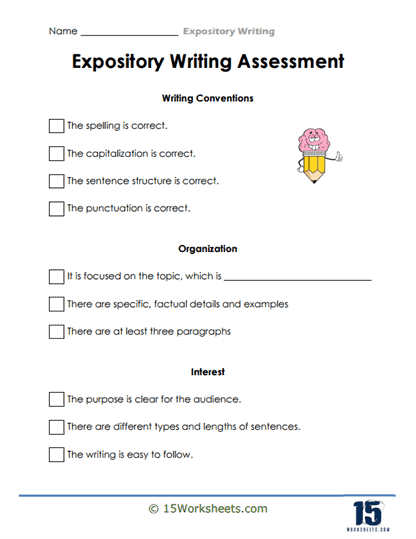
Conventions, Organization, Interest

The Expository Process
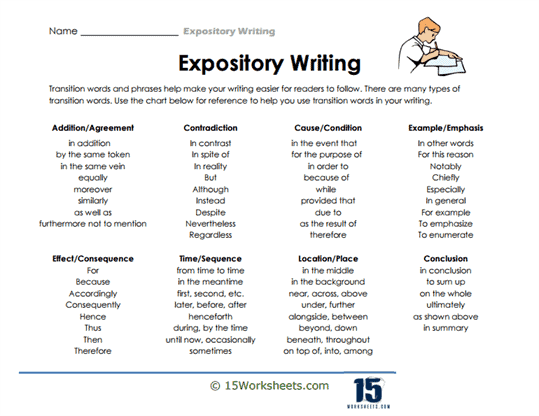
Transition Words and Phrases
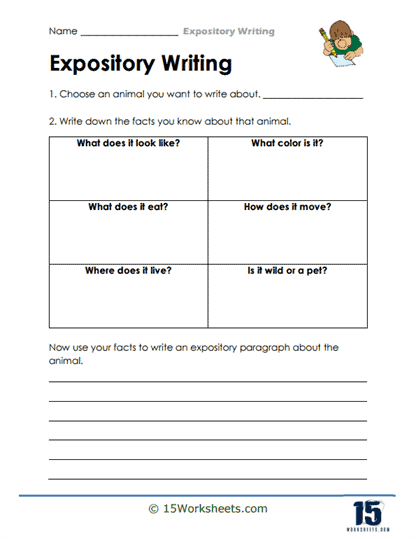
An Enjoyable Activity
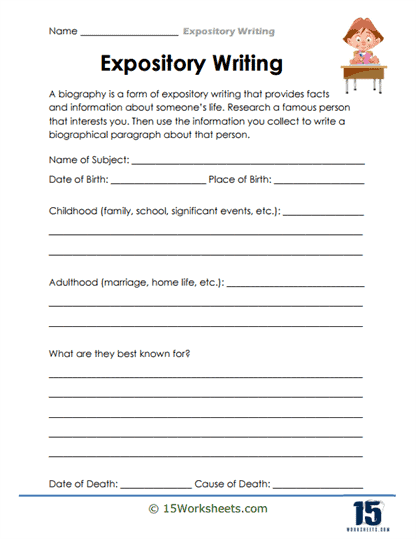
An Expository Biography
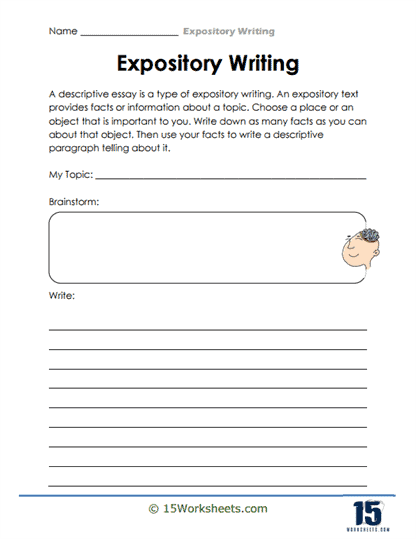
Expository Brainstorms
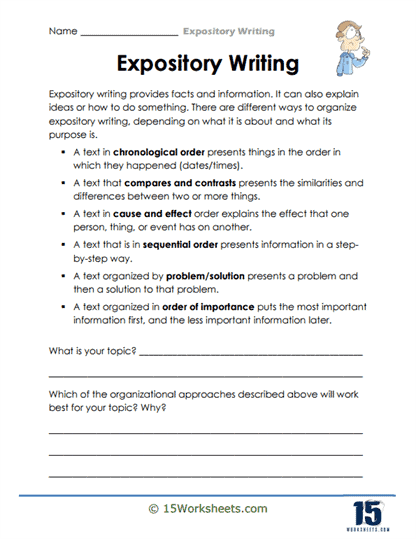
Different Expository Forms
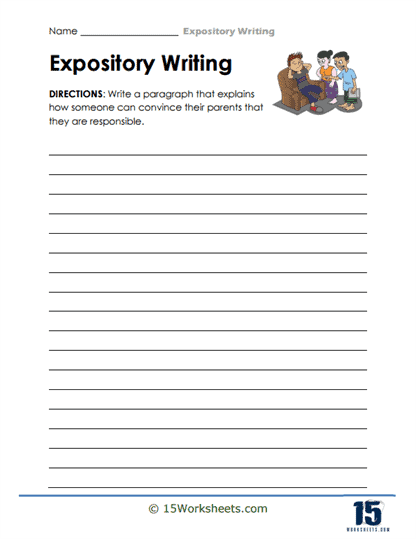
Convince Your Parents
About these 15 worksheets.
Expository writing is a form of writing that seeks to explain, inform, clarify, or expound on a subject. It’s a staple in academic settings and is commonly used in essays, reports, manuals, and textbooks. Its primary aim is to convey information in a clear, straightforward, and logical manner. Expository Writing worksheets are educational tools designed to develop and enhance students’ skills in this form of writing. They include various exercises targeting different aspects of expository writing, from structuring arguments to refining grammar.
Nature of Expository Writing
It is fact-based, focusing on exposing and explaining facts, concepts, or ideas. Unlike persuasive writing, it doesn’t include the author’s opinions or arguments but relies on factual and straightforward information. The primary purpose is to inform, explain, or describe. It’s widely used in educational materials, business reports, journalism, technical writing, and instructions.
Through a variety of exercises, these worksheets help in mastering the art of expository writing, from structuring arguments to refining grammar and vocabulary. This form of writing is crucial for academic success and professional communication, making these worksheets an invaluable component of educational curricula.
Types of Exercises
Structure and Organization Exercises – These exercises focus on structuring an expository piece, including the introduction, body paragraphs, and conclusion. This helps students understand how to organize their thoughts logically and coherently.
Topic Sentence Development – Activities that involve creating effective topic sentences that set the stage for the paragraphs. This enhances the ability to introduce the main idea of a paragraph clearly.
Evidence and Example Integration – Activities that involve using facts, statistics, or real-life examples to support the statements made. This enhances the ability to use evidence effectively to clarify and support the points made.
Transitional Phrases Usage – These exercises that involve using transitional words or phrases to ensure a smooth flow between ideas or paragraphs. Improves the readability of the text by creating logical connections.
Revision and Editing Tasks – These worksheets include revising and editing exercises to improve clarity, coherence, grammar, and punctuation. This encourages self-editing skills and attention to detail in writing.
Benefits of Practicing with Expository Writing Worksheets
Regular practice helps in developing a clear and concise writing style, essential for effective communication. It teaches students to avoid unnecessary details that can distract from the main message. By engaging in research-based exercises, students become adept at gathering and verifying information, a vital skill in academic and professional settings.
As students learn to support their statements with facts and examples, they develop critical thinking skills, learning to analyze and evaluate information critically. The process of writing, revising, and editing helps in refining grammar, vocabulary, and overall language proficiency. Expository writing is widely used in academic and professional contexts. Proficiency in this style is invaluable for success in these areas.
An Example of Expository Writing
Here’s an example of expository writing:
The Water Cycle – How Rain is Made
The water cycle is a fascinating natural process that helps create the rain we see falling from the sky. Imagine a big recycling system for water in nature! Let’s learn how this amazing cycle works.
Step 1 – Evaporation First, the sun shines its warm rays on lakes, rivers, and even the ocean. When the water gets heated by the sun, it starts to change into water vapor, which is like invisible steam. This process is called “evaporation.”
Step 2 – Condensation Next, the water vapor rises up into the sky. As it goes higher, it gets colder, and that makes the water vapor change back into tiny water droplets. These droplets come together to form clouds. This step is called “condensation.”
Step 3 – Precipitation Now, the clouds become heavy with all those water droplets. When they get too heavy, the water droplets fall from the sky as rain, snow, sleet, or hail. This falling of water is called “precipitation.”
Step 4 – Collection When the rain hits the ground, it doesn’t just disappear. It soaks into the soil and becomes part of rivers, lakes, and underground water sources. Animals and plants use this water too. This part is called “collection.”
And the cycle starts all over again! It’s like a never-ending journey for water in nature.
Why is the Water Cycle Important?
The water cycle is essential for life on Earth. It helps keep our planet’s water clean and fresh. Without this cycle, we wouldn’t have the rain we need for crops, or the water in our rivers and lakes. It’s also the reason we have beautiful rainbows when the sun shines through raindrops!
In conclusion, the water cycle is a natural process that keeps our planet’s water clean and provides us with the rain we need for many things. It’s like a big, amazing water adventure happening all around us every day.
Expository Writing Pdf Worksheets 2024
Research is used in expository writing to inform the reader. Research or informative writing also goes by the label of expository writing . Our printable expository writing worksheets get students thinking about how they will prepare for research and answer the prompt . It is becoming more and more common to conduct research using books, magazines, and the internet. It's crucial that kids understand how to conduct online research and properly reference their sources.
Even though they encounter it regularly in their daily lives, students frequently lack a firm comprehension of expository writing. Some examples of expository writing include how-to blogs on websites, textbook content, newspaper articles, or encyclopedia entries. It is a style of writing where all the information is factual. It resembles the reverse of creative writing in certain ways. Writing an expository essay requires a logical structure with a suitable introduction, body, and conclusion. This style of writing is objective, follows a chronological order, is highly clear, and provides information.
Your kids will be given available worksheets that explore expository writing's applications , including those in compare and contrast essays, how-to essays, and informative essays, as well as various other writing worksheets to finish a comparable task. When attempting to describe some sort of process, you should employ this writing style. It is one of the most fundamental kinds of communication and ought to be the main structure of every written work. Our collections of expository writing worksheets pdf will assist students in working up good academic essays.
18 filtered results
Behavior Activities
Handwriting
Social Studies
Pop Culture & Events
Arts & Crafts
Word Search
Multiple Choices
Fill In The Blanks
Word Scramble
Math Crossword Puzzles
Sentence Scramble
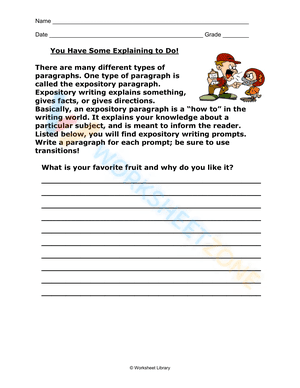
Expository Writing Worksheets Pdf 5
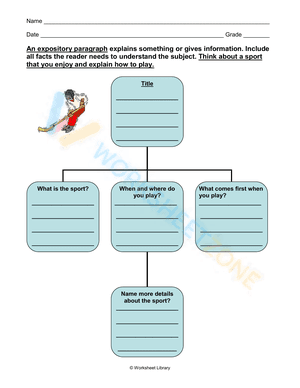
Expository Writing Worksheets Pdf 2
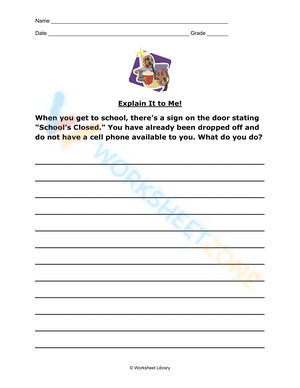

Expository Writing Worksheets Pdf 7

Expository Writing Worksheets Pdf 1
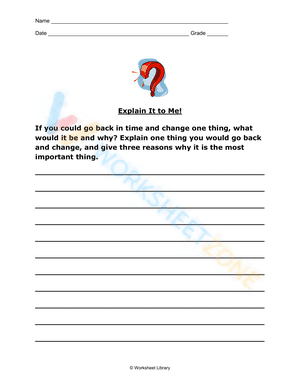
Expository Writing Worksheets Pdf 8
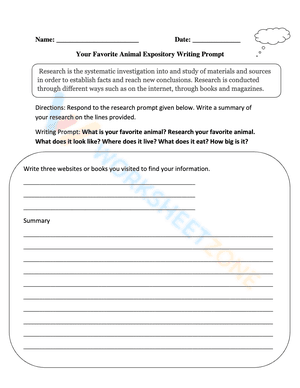
Your Favorite Animal Expository Writing Prompt
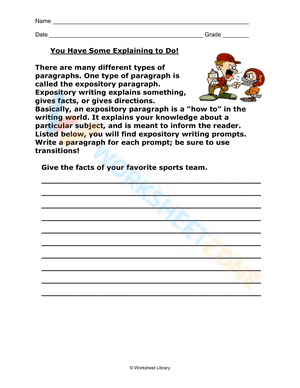
Expository Writing Worksheets Pdf 6

L-C-4-2_Finding A New Apartment
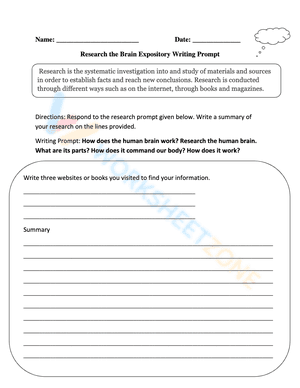
Research The Brain Expository Writing Prompt
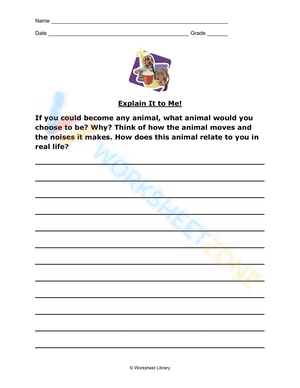
Expository Writing Worksheets Pdf 4

How To Make A Jam Sandwich
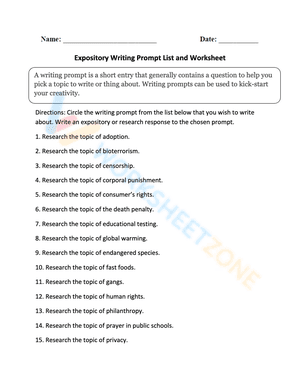
Expository Writing Prompt List And Worksheet
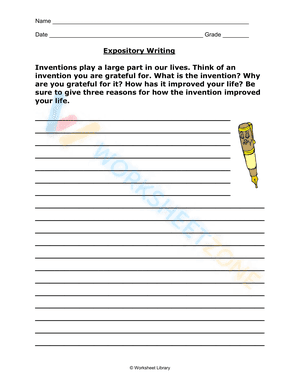
Expository Writing Worksheets Pdf 9

Research The Holocaust Expository Writing Prompt
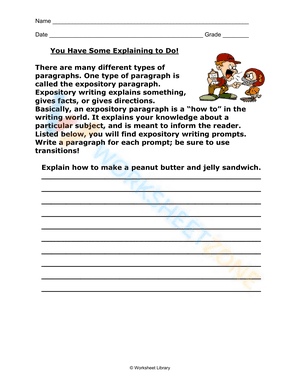
Expository Writing Worksheets Pdf 3
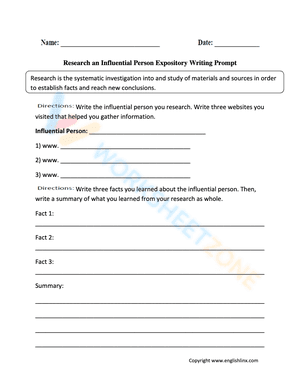
Research An Influential Person Expository Writing Prompt
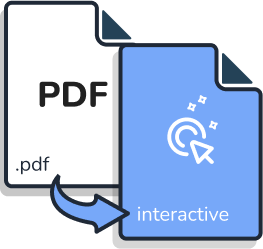
Expository Writing Worksheets Pdf 10
- List of All Subjects
- Worksheets by Subject
- Language Arts
- Expository Writing
Expository Writing Worksheets
Language arts categories, free weekly worksheets, worksheets by email, what is expository writing.
There are different forms of writings in English. Some of these include descriptive, narrative, persuasive, expository, and several others. The descriptive, narrative and persuasive writing is exactly what their name suggests. Expository writing is one that students do not usually have a clear understanding, even though they come across it very frequently in their daily lives. The how-to blogs on the website, the content in the textbooks, newspaper article, or an encyclopedia entry, these are some of the examples of expository writing. It is the form of writing that comprises of just factual information. It is, in a way, the opposite of creative writing. Expository writing uses a logical flow with a proper introduction, body, an conclusion. There are other forms of expository writing, and these include descriptive, sequential, comparative, cause/effect, problem/solution, and classification. Usage of descriptive language needs to be avoided at all times, and emotions should not be reflected in this form of writing. This type of writing is informative, offers a high degree of clarity, follows a chronological order, and is unbiased. Expository writing expresses the explanation and simplifies the topic. Such kind of writing help preschoolers in question/answer session that let them understand about everything. It also explains the reasons for the things happen. Also, there is an assumption that in case of expository writing, the teaching is occurring from scratch. A single teaching session consist of suggested name explanation. You may have read well-written form of expository writing in academic institution. It is kind of expository writing that is not only refer to essay writing such as The Value Triad, Paragliding, Global Village, etc. Authors prefer expository writing in different forms like How to/process, definitions, classification, comparison, contrast, cause, effect. Issue, solution, etc. Each kind of expository writing has different meaning. If one specifies the identification of issue in detail and suggest the best solution, the other one explains the impact of theme aspects. You also learn the comparison and differences among messages that the writer wants to convey in detail. The purpose of explaining story will also be a part of conversation between characters. You will also read things with full definitions and classifications in expository form of writing. Drive the reader’s mind towards how to process the procedure and the reason for its occurrence.

Give Me Three
Explain three reasons why something is a good choice. There are five different scenarios setup for you.
What Are the Types of Expository Writing?
There are four basic forms of writings. These include narrative, persuasive, descriptive, and expository. Expository writing is one where a writer is explaining, exposing, or elaborating on their stance. The type of writing that you read in the newspapers, manuals, textbooks, and encyclopedia articles is termed as expository writing. Expository writing is further divided into five categories. These categories include problem & solution, cause & effect, compare & contrast, definitions & classification, and how-to. Problem & Solution - This is a type of expository writing where the writer identifies an issue, elaborates on it, and suggest solutions that are backed by thorough research. Cause & Effect - The second type is the cause & effect. It is one where the writer talks about why a specific event took place, or a certain thing happened. Compare & Contrast - Here the writer compares and contrasts two or more perspectives, objects, or situations. Definitions & Classification - It is the type of writing which is explaining a specific topic and highlighting aspects such as definitions, effects, types, etc. How-to/Process - The fifth and the last type of expository writing is how-to/process. It takes the reader through a step-by-step process of completing a specific task.

Big Reasons
An expository paragraph explains something or gives information. Include all facts the reader needs to understand the subject. Think about several things and explain why.

You Have Some Explaining to Do!
There are many different types of paragraphs. One type of paragraph is called the expository paragraph. Expository writing explains something, gives facts, or gives directions. Basically, an expository paragraph is a "how to" in the writing world. It explains your knowledge about a particular subject, and is meant to inform the reader. Listed below, you will find expository writing prompts. Write a paragraph for each prompt; be sure to use transitions!
Tips on Writing an Excellent Expository Pieces
Expository writing is one of the four basic forms of English writing. It is a very different form of writing, as it does not include any ‘creative’ aspects. It revolves around factual information and does not include any opinions. Many students struggle with creating expository pieces that are impactful because they are very different from the ones students like working on, such as narrative, descriptive, and story writing. So, how can you write an excellent expository piece? Firstly, you need to make sure that the wording you use is concise and clear. In minimum use of words, the reader knows exactly what you are talking about in your piece. The best approach in this type of writing is to use third-person pronouns, especially when writing an objective essay. You can also use the first-person pronounce when the piece you are creating revolves around personal experience. You need to really focus on the thesis statement as it is the focal point of the essay. Do not mix the paragraph themes. Each paragraph needs to cover one topic only. Starting with your strongest point and then adding the supporting ideas is the ideal structure of an expository piece. You can also make use of transition words. Your conclusion should be very powerful. Make sure to cite your sources.

Explain It to Me!
You will be given all types of different scenarios to work with. We made enough different versions so that everyone in a class can have their version to work on.
What to Avoid in Expository Writing
The formal research papers that you read to gather reliable and authentic details follow a writing style known as Expository writing. It is one of the basic forms of writing. Almost all academic papers follow this form of writing. While it helps put down your arguments formally, it even teaches you the skills to construct independent arguments. So, we know that expository writing is a formal way of writing arguments, but we do not know what to avoid in this type of writing. To excel in it, you need to know what you got to avoid here. 1. Failing to address the topic in the introduction. The readers need to understand exactly what they will achieve after completing the writing; it is one of the crucial steps in this form. 2. Straying from the focus of the essay. One thing that you need to be sure about is to stay close to the purpose of your article. 3. Adding quotations in the article, without explaining the reference or building a link with the rest of the content. 4. Not adding references or citing the source of information is one of the biggest blunders you can do with your expository writing. It is critical to back your findings with the right sources. 5. Use of informal language, rhetorical questions, or colloquialisms is strictly not allowed in this form of writing. These are the things that you need to avoid when creating expository pieces. Following these five tips will help you create powerful expository articles.

Giving a setup for yourself you will write a five paragraph essay with your take on it.

IMAGES
VIDEO
COMMENTS
Expository Writing worksheets are educational tools designed to develop and enhance students’ skills in this form of writing. They include various exercises targeting different aspects of expository writing, from structuring arguments to refining grammar.
Your students will be provided sheets that examine the uses of expository writing-such as in compare and contrast essays, how-to essays, and informative essays-and be given several worksheets to complete a similar task.
Writing an expository essay requires a logical structure with a suitable introduction, body, and conclusion. This style of writing is objective, follows a chronological order, is highly clear, and provides information. Your kids will be given available worksheets that explore expository writing's applications, including those in compare and ...
Each kind of expository writing has different meaning. If one specifies the identification of issue in detail and suggest the best solution, the other one explains the impact of theme aspects. You also learn the comparison and differences among messages that the writer wants to convey in detail.
Expository Writing Worksheets - Free to print (PDF files) for ELA (English Language Arts) students and teachers.
These 13 worksheets help students build their explanatory/ expository writing skills. In the collection, you'll find two worksheets that break down the writing process, a number of prompts with a checklist to guide students as they respond, and some open prompts.